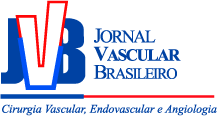Experiência preliminar com novo filtro de veia cava: resultados de 15 implantes
Preliminary experience with a new vena cava filter: results of 15 implantations
Winston B. Yoshida; Hamilton A. Rollo; Mariângela Giannini; Marcone L. Sobreira; Regina Moura
Resumo
Palavras-chave
Abstract
Keywords
References
Yoshida WB, Lastoria S. Procedimentos de interrupção venosa na trombose venosa profunda e embolia pulmonar. Doenças vasculares periféricas. 2002;2:1473-85.
Greenfield LJ, Michna BA. Twelve-year clinical experience with the Greenfield vena caval filter. Surgery. 1988;104:706-12.
Katsamouris AA, Waltman AC, Delichatsios MA, Athanasoulis CA. Inferior vena cava filters: in vitro comparison of clot trapping and flow dynamics. Radiology. 1988;166:361-6.
Kinney TB. Update on inferior vena cava filters. J Vasc Interv Radiol. 2003;14:425-40.
Streiff MB. Vena caval filters: a comprehensive review. Blood. 2000;95:3669-77.
Aswad MA, Sandager GP, Pais SO. Early duplex scan evaluation of four vena caval interruption devices. J Vasc Surg. 1996;24:809-18.
Messmer JM, Greenfield LJ. Greenfield caval filters: long-term radiographic follow-up study. Radiology. 1985;156:613-8.
Abad C, Pomar JL, Morales MA. [Accidental opening of a Greenfield filter at the right atrium]. Angiologia. 1990;42:182-4.
Greenfield LJ, Peyton R, Crute S, Barnes R. Greenfield vena caval filter experience: late results in 156 patients. Arch Surg. 1981;116:1451-6.
Lang W, Schweiger H, Fietkau R, Hofmann-Preiss K. Spontaneous disruption of two Greenfield vena caval filters. Radiology. 1990;174:445-6.
Donaldson MC, Wirthlin LS, Donaldson GA. Thirty-year experience with surgical interruption of the inferior vena cava for prevention of pulmonary embolism. Ann Surg. 1980;191:367-72.
Kupferschmid JP, Dickson CS, Townsend RN, Diamond DL. Small-bowel obstruction from an extruded Greenfield filter strut: an unusual late complication. J Vasc Surg. 1992;16:113-5.
Rogers FB, Shackford SR, Ricci MA, Huber BM, Atkins T. Prophylactic vena cava filter insertion in selected high-risk orthopaedic trauma patients. J Orthop Trauma. 1997;11:267-72.
Greenfield LJ, Proctor MC, Cho KJ. Extended evaluation of the titanium Greenfield vena caval filter. J Vasc Surg. 1994;20:458-64.
Rogers FB, Strindberg G, Shackford SR. Five-year follow-up of prophylactic vena cava filters in high-risk trauma patients. Arch Surg. 1998;133:406-11.
Kinney TB, Rose SC, Weingarten KE, Valji K, Oglevie SB, Roberts AC. IVC filter tilt and asymmetry: comparison of the over-the-wire stainless-steel and titanium Greenfield IVC filters. J Vasc Interv Radiol. 1997;8:1029-37.
Yoshida WB, Sequera J, De Abreu Maffei FH. Long-term histopathologic evaluation of inferior vena cava after modified Greenfield filter implantation: Experimental study in sheep. Int Angiol. 2004;23:170-6.
Dorfman GS. Percutaneous inferior vena caval filters. Radiology. 1990;174(3):987-92.
Eight-year follow-up of patients with permanent vena cava filters in the prevention of pulmonary embolism: the PREPIC (Prevention du Risque d'Embolie Pulmonaire par Interruption Cave) randomized study. Circulation. 2005;112:416-22.
Hingorani A, Ascher E, Markevich N. Risk factors for mortality in patients with upper extremity and internal jugular deep venous thrombosis. J Vasc Surg. 2005;41:476-8.
Rectenwald JE, Greenfield LJ, Henke PK, Proctor MC, Wakefileld TW. Vena caval interruption procedures. Vascular surgery. 2005;2:2198-216.
Yoshida WB, Rollo HA, Lastoria S, Maffei FHA. Interrupção venosa como tratamento de exceção na trombose venosa profunda e embolia pulmonar. Cir Vasc Angiol. 1987;3:23-9.
Streiff MB. Vena caval filters: a review for intensive care specialists. J Intensive Care Med. 2003;18:59-79.
Baglin TP, Brush J, Streiff M. Guidelines on use of vena cava filters. Br J Haematol. 2006;134:590-5.
Decousus H, Leizorovicz A, Parent F. A clinical trial of vena caval filters in the prevention of pulmonary embolism in patients with proximal deep-vein thrombosis: Prevention du Risque d'Embolie Pulmonaire par Interruption Cave Study Group. N Engl J Med. 1998;338:409-15.

